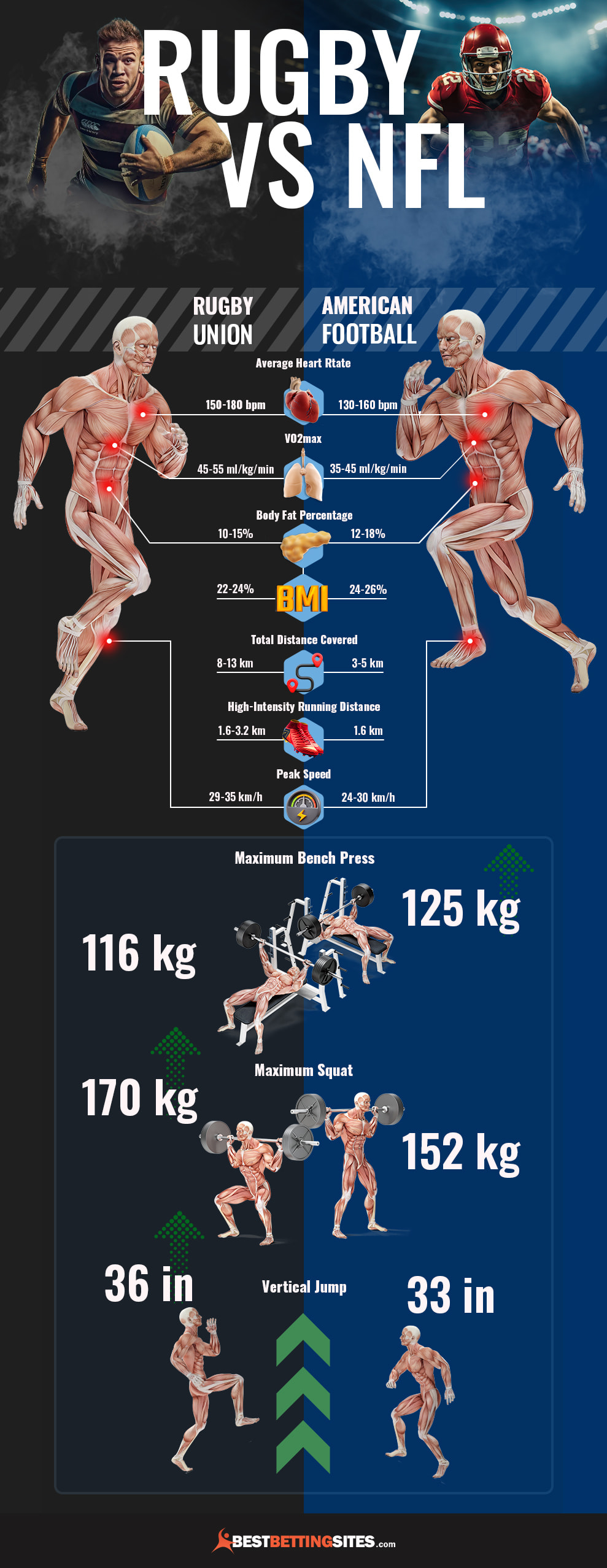Rugby Union vs American Football: A Comparison of Physiological Demands
Rugby Union and American Football rank among the most popular sports in the world today. Follow the NFL season and witness the highs and lows of the United States’ most popular professional sport. From a jam-packed regular season to the nervousness of the playoffs and the glamour of the Super Bowl, it’s no surprise the NFL attracts millions of viewers worldwide. If you’re in Europe, you’ll likely prefer the unpredictable and exciting world of Rugby Union and the always-popular Six Nations
Like the world of combat sports, where comparisons are made between boxing and mixed martial arts, Rugby Union and American Football share many similarities. Both are equally demanding, professional, and risky sports, played by the bravest, fittest, and most ambitious players. If you’ve ever watched the Rugby World Cup, you’ll know the sport is better followed today than at any stage in history due to increased revenue brought about by live television coverage of the top games.
Age-old argument
Now and again – usually when the sports schedule is slow – we see an age-old debate resurface regarding the sports of Rugby Union and American Football. Which is more demanding? Rugby betting fans say the absence of padding makes their sport more demanding, dangerous, and, in turn, better to watch. American Football fans point to the sheer size and speed of the best players, arguing the NFL boasts more complete athletes than Rugby Union could ever dream of producing. Which side of the fence do you sit on this one?
We appreciate, like boxing and MMA, that there’s no right or wrong answer to which sport is better, more dangerous, and, as such, more demanding. A strong case could be made for either sport being the best, but it’s unlikely there will ever be a time when everyone agrees. Sports fans are fiercely protective of their favourites, backing them all the way to the finish. Choosing between Rugby Union and American Football, or the Rugby World Cup and the NFL, is a matter of personal preference.
In this article, we delve into the stats, highlighting the best and strongest arguments for Rugby Union being the best and then the most convincing arguments for American Football standing tallest. Keep reading as we investigate the metrics of both sports, vital stats, speed, intensity, movement analytics, and more. We use technology to help us arrive at a conclusion and provide an answer to the question of which sport is more demanding, Rugby Union or American Football.
Comparisons
Let’s start with the most obvious point. Although there are many comparisons between Rugby Union and American Football, they are two very different sports in some respects. Style of play, rules, pitch size, substitutions, and protective equipment all differ. Rugby is a high-intensity game played for 80 minutes of almost non-stop action, whereas American Football has more explosive bursts of energy, separated by periods of rest and change. The demands on the players’ fitness are different but have an NFL player and a Rugby Premiership player tackle you to the ground, and the differences between the sports won’t matter as much. Both are demanding, dangerous, and mesmerising. Both require elite levels of physical fitness, mental toughness, power, and speed just to make it onto the field.

The differences between Rugby Union and American Football are obvious in the build, size, and stature of the best players. NFL stars are often bulky, muscular, and tall, which is perfect for taking the heavy knocks associated with the sport. The cream of the crop from the world of rugby is often leaner, fitter, and faster, allowing them to compete for 80 minutes of running, tackling, and defending.
Let’s take a closer look at the two sports, highlighting the key physiological attributes and metrics between a rugby player and a football lover. The table covers many important aspects of the sports, like movement patterns, power output, injuries, intensity, and more. Everyone has an opinion on which sport is better and more demanding, but the numbers never lie.
| Metric | Rugby Union | American Football |
| Total Distance Covered | 8-13 km | 3-5 km |
| High-Intensity Running Distance | 1.6-3.2 km | 1.6 km |
| Average Speed | 19-24 km/hr | 11-19 km/hr |
| Peak Speed | 29-35 km/hr | 24-30 km/hr |
| Average Heart Rate | 150-180 bpm | 130-160 bpm |
| VO2max | 45-55 ml/kg/min | 35-45 ml/kg/min |
| Maximum Bench Press | 116 kg | 125 kg |
| Maximum Squat | 170 kg | 152 kg |
| Vertical Jump | 36 in | 33 in |
| Injuries per Season | 3-6 | 8-12 |
| Concussions | Higher rate | Lower rate |
| Work:Rest Ratio | 1:20 | 1:10 |
| High-Intensity Bout Duration | 10-15 sec | 2-5 sec |
| BMI | 22-24 | 24-26 |
| Body Fat Percentage | 10-15% | 12-18% |
| Aerobic Endurance | Excellent | Good |
Breakdown of movement
The above table gives us many interesting points, not least the overall running and the workload of Rugby Union and American Football players. As you can see, rugby players spend more time moving during a game, and that will come as no surprise to anyone who has watched both sports. Rugby is more physically demanding, certainly in terms of cardio, whereas football is more tactical, with precision movements aimed at catching opponents off-guard to steal yards and points.
Let’s now focus on the quality of running work during a game rather than the distance covered. The high-intensity running tracks ultra-demanding sprints which, although less frequent, are every bit as demanding. Would you rather run for five miles constantly or sprint 400 metres regularly? These tasks require very different types of fitness and endurance. Rugby props typically cover up to two miles of high-intensity runs, whereas NFL players will sprint for around a mile on average.
What about the speed involved? Does a Rugby Union regular run faster than an American Football player? Rugby players battling for the ball will often run at an average speed of 12-15 mph, and that’s quicker than their colleagues over at the NFL, where they travel at around 10-15 mph, depending on their position. There’s not too much in it when focusing on running speed.
Distance covered
The table below highlights the typical distance covered in a game by a Rugby Union player and the position played.
| Position | Distance (km) |
| Prop | 6-10 |
| Lock | 6-10 |
| Flanker | 8-11 |
| Number 8 | 10-13 |
| Scrum-half | 5-8 |
| Fly-half | 3-6 |
| Centre | 5-6 |
| Wing | 5-8 |
| Fullback | 3-6 |
Let’s now compare those findings to the average distance and position for the top positions on an American Football field.
| Position | Distance (km) |
| Quarterback | 2-3 |
| Running Back | 5-8 |
| Wide Receiver | 3-6 |
| Tight End | 5-8 |
| Offensive Lineman | 3-5 |
| Defensive Lineman | 6-8 |
| Linebacker | 8-11 |
| Defensive Back | 3-6 |
Heart rate
A great indicator of which sport is more physically demanding is found in the results of heart rate monitors and similar tests. As you will see from the table posted below, the stop-start nature of NFL games ensures the heart rates of players spike at 190 bpm, and that’s not too dissimilar to Rugby Union players and their 180 bpm.
We now know football gets the heart working faster and harder than rugby, but that doesn’t give us the complete picture. VO2max measures oxygen circulation and utilisation (ml/kg/min). Rugby has a higher score here, and that reflects the fact most players on the field are working and moving for the entire 80 minutes. Below is the average heart rate in BPM in rugby and American football.
| Position | Avg Heart Rate (BPM) |
| Prop | 160-180 |
| Lock | 155-175 |
| Flanker | 165-185 |
| Number 8 | 170-190 |
| Scrum-half | 150-170 |
| Fly-half | 145-165 |
| Centre | 150-165 |
| Wing | 155-175 |
| Fullback | 145-165 |
Average Heart Rate by NFL Position
| Position | Heart Rate (BPM) |
| Quarterback | 130-150 |
| Running Back | 150-160 |
| Wide Receiver | 155-175 |
| Tight End | 150-165 |
| Offensive Lineman | 140-160 |
| Defensive Lineman | 160-180 |
| Linebacker | 170-190 |
| Defensive Back | 150-170 |
Player strengths
Putting the individual sports to one side for a second, let’s look at some of the typical strength scores for players from professional rugby and football. A typical rugby prop can benchpress around 136kg, which is mightly impressive in itself, but the NFL stars have an edge here, pushing up to 180kg, and that’s quite a difference.
Sticking with that train of thought, let’s place some others under the microscope in an interesting test of strength. Elite rugby props and number eights squat over 181 kg! While ambitious gym-goers aim 1.5-2 times their body weight with good form. Vertical jumps are also a great indicator, and we know from official tests that elite-level rugby back can jump on average 30 inches vertically while an NFL regular wouldn’t get close to that. For context, a fit and regular gym user would be happy with around 16 inches in the same test.
Injuries
Injuries are also worth checking and referencing. Now, more injuries don’t necessarily mean a tougher sport. You get more injuries playing soccer than competing in professional boxing, but most would consider boxing a much tougher and more demanding sport than soccer. Check the tables below for some interesting points on injuries in these sports and the most influential playing positions.
| Position | Injuries per Season |
| Quarterback | 8-12 |
| Running Back | 7-10 |
| Wide Receiver | 6-9 |
| Tight End | 5-8 |
| Offensive Lineman | 10-14 |
| Defensive Lineman | 9-13 |
| Linebacker | 7-11 |
| Defensive Back | 6-9 |
Intensity
We already know and have proven with stats that rugby is a more intense game than football, mostly because the players spend 80 minutes on the field while a typical NFL game is stop-start with brief periods of high-intensity sprints broken up by long breaks. Let’s look at the sports’ intensity by position.
| Position | Work:Rest Ratio |
| Prop | 1:20 |
| Lock | 1:20 |
| Flanker | 1:15 |
| Number 8 | 1:12 |
| Scrum-half | 1:10 |
| Fly-half | 1:8 |
| Centre | 1:10 |
| Wing | 1:12 |
| Fullback | 1:8 |
Conclusion
The comparisons between two sports are a popular conversation piece for fans, like is boxing or MMA the ultimate combat sport or is rugby more dangerous than football due to the lack of padding and protective clothing. Despite all the stats and comparisons, one thing shone brightest for me, and that’s both sports and extremely tough to play at an amateur level. Those in the professional ranks are supreme athletes, regardless of their performances, earnings, awards, and the teams they play for.
To make it as a professional rugby player or pro footballer requires speed, fitness, strength and endurance. We should take the time to really appreciate the best players in both sports as they put their minds and bodies on the line for our entertainment. It’s likely a top-performing NFL player could, with the right training, hold his own in the world of Rugby Union and vice versa. Choose your favourite In terms of which sport is better to watch, that’s a matter of personal opinion. You may appreciate the high intensity of Rugby Union and the mental toughness of the players involved, who operate at a high level, playing for 80 minutes without a break and minus the padding and protection enjoyed by the top names in the NFL.
When looking at American Football, you’ve got to love the short sprints and explosive power of the sport. Players are required to enter the field and make a difference in minutes before leaving the pitch and returning to a state of rest. Getting your body in line with the start-stop demands of football is no mean feat. Is long-distance running more taxing than sprinting for 100 metres and trying to be as quick as possible? Now imagine doing both, but with opposition players trying to flatten you at every turn.
References
Angelini, C. et al. (2022). Time-Motion Analysis in Rugby Union vs American Football. Journal of Sports Sciences. 40(3), 305-312.
Bar-Or, O. et al. (1980). Physiological Characteristics of High-Level American Football Players. Medicine & Science in Sports & Exercise. 13(4), 228-233.
Bloomfield, J. et al. (2022). Physiological Profile of Elite Rugby Union Players: A Systematic Review. Sports Medicine – Open. 9(1), 55.
Buchheit, M. et al. (2007). A Comparison of Physiological Demands in Rugby Union and American Football. International Journal of Sports Physiology and Performance. 2(3), 223-235.
Dubois, R. et al. (2022). Movement Patterns in Elite American Football Players: A Systematic Review. Journal of Strength and Conditioning Research.
Hartwig, T. et al. (2022). Quantifying Workload in Professional Rugby Union: A Systematic Review. Journal of Sports Sciences. Epub ahead of print.
Kerr, Z. et al. (2022). Understanding Sport-Related Injury Patterns: A Comparison of Rugby and American Football. [version 1; peer review: 2 approved]. Sports Medicine – Open 8(1), 17 (2022).



